* (restored/expanded)
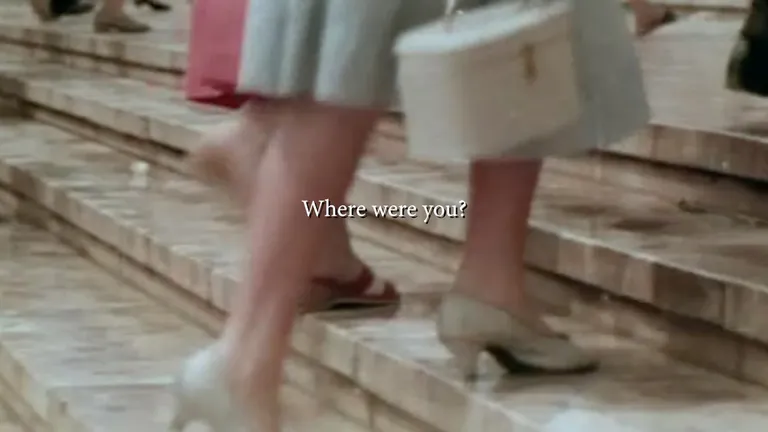
‘Mark Rappaport is on the very short list still for the greatest living American filmmaker because of the absolutely essential work he did, first in his early fictional narratives from 1974’s Casual Relations up through 1985’s Chain Letters, then in a second phase of fictional autobiographies of movie stars that have an utter lack of use for the tenets of realism that’s inspiring, especially seeing how they were made parallel to the dire trend in more commercial US cinema of “realist” (re: swearing and torture scenes) genre films that proliferated in the early 1990s.
‘Rappaport’s stance on the narrative and “psychological” shibboleths that loiter, tired but possessed with insidious powers of seduction, in the dire waiting room of the vast majority of American and world cinema collecting gilded dildos and money in a manner that inclines one to agree with the psychoanalytic tendency to trace the origins of such tendencies to the infant’s urge to play with feces, is revolutionary because it doesn’t violently reject such things in search of the real, but deflates them so they’re no longer gods to be venerated or scorned but half-remembered scraps in the junk pile ghost story of consciousness. While often screamingly funny, they’re just as often uncomfortable as listening to a recording of one’s own voice. Frequently in the same segment.
‘While his early shorts are amusing, especially Blue Movie, the best place to come to an appreciation of Rappaport’s distinctive style is his first feature Casual Relations, a collection of around 12 shorter meditations on the place of boredom, apathy, and in-between moments. It doesn’t have quite the same Jamesian complexity of his later narratives but is, as these sorts of things go, straightforward, hilarious, and more digestible. Casual Relations establishes Rappaport as perhaps the only American filmmaker to understand the artistic potentials and the specific textures of what’s been crudely dubbed “the postmodern condition”-he’ll use outdated stylistics for his own purposes and switch them out frequently and without concern for reveling in or directly and narrowly commenting on them-they’re language, and language is a tool that he’s free to use however he sees fit and established style something he can pick up or discard at whatever tempo he chooses. An especially memorable sequence superficially resembling Rashomon perhaps best sums up this peculiar film whose greatest asset is its lack of a center. A stabbing or shooting occurs, and we see it in various states of revision until it comes up against the void of meaninglessness and becomes more and more absurd. Pluralism isn’t the keyword but rather the emergence of something more sinister, more given to dangerous laughter, something more all-encompassing, a trap perhaps…it’s no accident the film ends with Martha and the Vandellas’ “Nowhere to Run” playing over a blank screen and then credits…
‘The later films tie their strands together in more complex ways than simply a shared theme make them more complex. It took me three failed runs through his later Local Color before I could allow myself to be ensnared in it’s internal logic, but on the third time it was sheer delight, dread and awe that the movies could do such things. The film, his third (I’ve yet to track down a copy of Mozart in Love though it’s now available on Fandor and I hope to review it here soon) is his masterpiece, though in a body of work this good that means it’s a split second finish. A story of incredible complexity and one of the only, maybe the only, besides Rappaport’s own The Scenic Route, film to take the innovations of the greatest post-war writers in prose, the Pynchons and Barthelmes and Gaddises, and employ them to film on the same level to and sometimes even surpass them. To recount the plot here would be to miss the point; the plot is so byzantine and winding that it seems so on purpose so as to force the viewer in being overwhelmed to let go and stop reading it the way they’ve always read films; as things with characters who have goals and represent eternal melodramatic forces. Nothing is so cut and dried here. Character isn’t a matter of surface level coherence but of self-contradiction, petty urges with unknown origins, layers of masks draped one over the other like thatch over a pit. Attempts have been made to imitate the power and unusual tone of this film in later films to such dire effect it would be insulting to Local Color to mention them here. Some of these attempts were by filmmakers I’m not even sure saw Local Color, maybe the impetus came to them half-digested in dreams. Such things happen.
‘The second phase of Rappaport’s career involves the fake auto-biographical films that started with the classic piece of film criticism Rock Hudson’s Home Movies, a film that despite its many technical issues (the sound desperately needs to get remixed if it’s ever rereleased-Mark I know you’re reading this) redefines the boundaries of both the single subject historical documentary and the film-as-film criticism, and offers incredibly useful reinterpretations to some of the major tenets of postmodern criticism. Like the rest of his films, it’s screamingly hilarious.
‘Through the novel technique of using an actor to play the deceased Hudson who then guides the audience through a collection of clips from Hudson’s films Rappaport brings seasoned viewers to uncomfortable problems of film criticism rapidly and with gleeful abandon. By positing that Hudson was expressing his closeted homosexuality in his choices as an actor, both in scripts and performance, the cinema so straitjacketed into misreadings of French auteur theory, is broken up into an almost inconceivable spectrum of subjectivity; reading film is no longer the bitter struggle with a jigsaw puzzle of images in hopes for the imperialist domination of the “final reading”, the “director’s intent”, a flag of interpretation to hoist up, a meat thermometer to stick in so as to have the satisfaction of saying “It’s done”, but an act of imagination with no possibility of triumph beyond hard to articulate resonances. That the actor playing Hudson looks little or nothing like him, a fact driven home repeatedly by his literally being posed next to pictures of the actual Hudson, works because it shows the intent is not to bring Hudson back to life in the creepy necrophile manner of so many bio-pics obsessed with the actor’s superficial resemblance to the deceased.
‘How much of self is social? How much of the social self is noticed even if it is? When taking the text on its own terms what sorts of rabbit holes might we stumble into? If trying to find the author (in this case Hudson) is a doomed task of endless supplements and uncomfortably off doubles must this be viewed with the bitter taste of having been betrayed by stories of the possibility of truth? Or can the lack of “truth”, of recovery of the dead, be seen on its own terms as a new aesthetic path defined by an almost unlimited potential?’ — Dan Levine
____
Stills








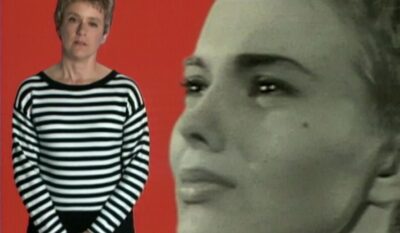





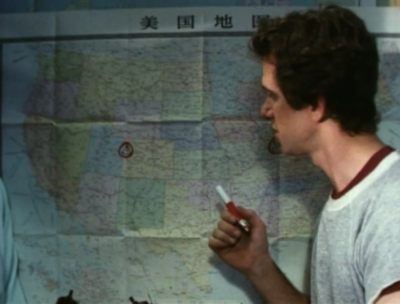



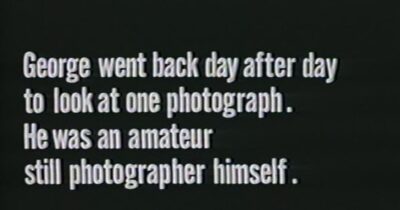










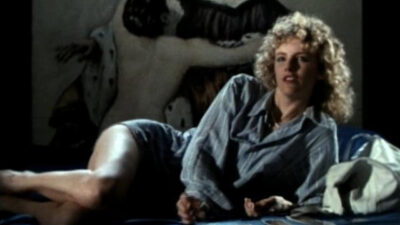







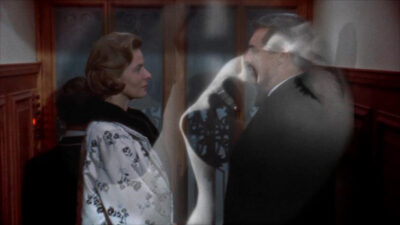

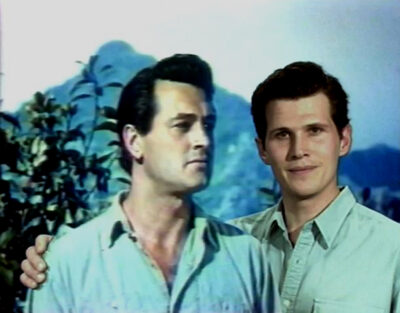

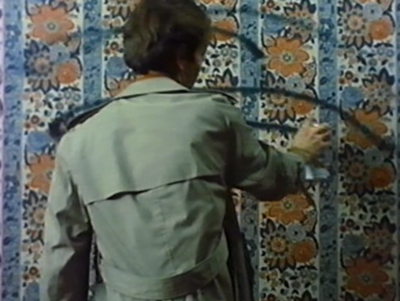
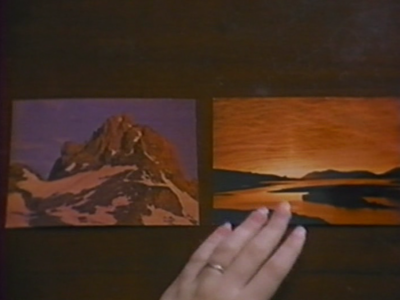


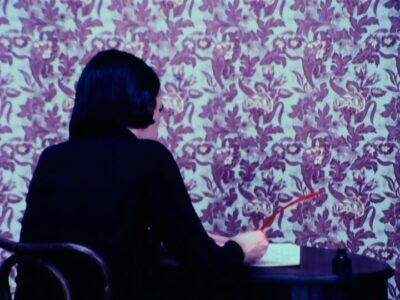





____
Further
Mark Rappaport @ IMDb
The Strange and Sad Saga of How Filmmaker Mark Rappaport Lost His Movies
Mark Rappaport on His Movie Archaeology: “If I get pretentious with this, slap me senseless”
MEDIUM FOR A DEAD PERSON: MARK RAPPAPORT COMES TO FANDOR
Mark Rappaport Fires Back at Ray Carney
AN INTRODUCTION TO THE WORKS OF MARK RAPPAPORT
Man on a Shoestring: An On-Location Report on Mark Rappaport’s IMPOSTORS
all that editing allows
Mark Rappaport: Snapshots of the Man Wearing the Mask
Mark Rappaport on Proust and Marienbad
Image and Voice: The Audiovisual Essays of Mark Rappaport
Podcast: Mark Rappaport on Fresh Air
‘Rock Hudson’s Home Movies’ Hits Criterion: Seeking the Hidden In the Evident
Mark Rappaport’s From The Journals of Jean Seberg
AN ESSAY BY MARK RAPPAPORT ON PHANTOM AND DISSOLUTION
Podcast: Film Essayist Mark Rappaport, Directorial Left Turns
_____
Extras
Breaking Through the Screen: Movies by Mark Rappaport
Mark Rappaport | Interview at Curtocircuíto 2016
Continuidades e descontinuidades na obra de Mark Rappaport
____
Interview

When you read pieces by people like me calling you “the father of the modern video essay,” what do you think? Do you say, “What the hell are these people talking about?”
Um, no. I think I know what they’re talking about. It makes me feel very old indeed, but no, I kind of get it, because in some sense, these sorts of films are the kind of thing that [Jean-Luc] Godard, 24 years ago, pointed the way toward, with new technology that was not available to me.
Are you talking about “Rock Hudson’s Home Movies” now, specifically, or a different one of your films?
“Rock Hudson’s Home Movies” and “From the Journals of Jean Seberg,” both. The new technologies have made that way of thinking more possible. I’m very glad that I’ve lived to partake in all of these technologies, because before the VHS player, you were kind of at the mercy of your memory and repertory theaters. VHS and subsequently DVDs and Blu-rays and Internet has made [my] kind of reconsideration of our recent past possible, and that’s very gratifying that this stuff can be made, and can be made available very quickly.
When I made “Rock Hudson’s Home Movies,” I had to transfer it to film in order to have it seen, period. And it was very expensive, making the transfer from video to a 16 mm film, and then you had to mail out the prints [to theaters]! Of course now, with the Internet all this stuff is right there, it’s like one-stop shopping. You do it, you click on it, it’s out there, so this is quite amazing.
My parents were a lot older than most people’s parents, and I always wondered how they made the transition from horses to automobiles, from nothing to radio and then to televise, and I feel that I’ve been living on a similar time of the transition technologically, going from TV to means of reproduction where you could have all this stuff in your house—that is to say, your favorite movies on VHS and then DVD, and now at your fingertips, on your two-way wristwatch.
I’ve just watched—I had never seen it before—your short film, “Mark Rappaport: The TV Spin-Off.” That’s from 1978. It starts out with you—I guess you’re just physically leafing through stills—and talking about these images in close-up. And then you start talking about your movies, and it hit me all of a sudden that this is basically the narrated video essay as it is practiced today, except we’re ripping DVDs with HandBrake and ripping them in Adobe or Final Cut Pro or something like that. But you’re just a guy moving pictures around with his hands and talking, and I guess either you or someone else is triggering the music that plays in the background behind you, right?
Yeah.
Is what you were doing in 1978 a more basic approach to the same kind of idea?
Yeah, yeah! Well, I think I’ve always been very limited, I guess we all are—we see things from one perspective and basically we live our lives from that one particular perspective, but I think I was talking to somebody fairly recently. I said, “I re-saw the first movie I had ever made, and everything in that movie is there, and I will draw on it for the future, and things that I made today relate to that movie.” You know, like people against a background of a huge still. And I was just shocked when I realized that, because it was almost fifty years ago that I made that!
One is always a prisoner of one’s own life, in a sense. But that’s a good sense.
If had wished for something 20 years ago, I would have wished for Final Cut Pro, but I am not a visionary, and I could want things, but I couldn’t invent them, any more than I could invent VHS or DVDs or the delivery of movies to your home though the Internet.
Could you walk me through your evolution as a filmmaker in regards to your storytelling devices? Specifically, the point at which you decided to use actors to represent stars, such as Rock Hudson and Jean Seberg? They are not speaking dialogue that is supposed to be Rock Hudson or Jean Seberg as we might think of them in a docudrama.
I have no idea! I don’t remember quite at which point I was going to make “Rock Hudson.” It was always going to be a first-person narrative, and obviously that person is dead and wouldn’t, in all likelihood, have the insights into his life and work that I might’ve had. I don’t know, I think when I had to write stuff up for film festivals, I decided on this format called “the fictitious autobiography.”
Yes, I remember you using that phrase when I interviewed you in back in ’95.
Oh really? [laughs] Oh god, how dull of me.
No no! It just stuck in my mind because it’s a great phrase. I was struggling—I had asked you to help me to describe what you were doing in films like “From the Journals of Jean Seberg” and “Rock Hudson’s Home Movies.” I was writing for a pretty wide readership, most of who had probably never seen anything like the work you were doing at that time. When you watch those movies, you are seeing Rock Hudson and Jean Seberg as you might see them in a biography, but at the same time, they are saying things that those people would never say because Rock Hudson and Jean Seberg don’t have the knowledge of a film historian or a critic.
That’s right. They couldn’t have an overview of their careers before they died.
I was saying “fictitious biography” even back then, when you first interviewed me, because I had written something for film festival catalogues, and they want to know what the artist’s intent is.
They never ask real filmmakers about this, they only ask experimental types. “Tell me what it means, the author’s intent.” Has anyone ever asked Stanley Kubrick, “What does it mean?” I don’t think so.
[laughs] No, probably not.
They would be afraid of getting bitten in half, anyway. “What does the bone turning into the spaceship mean?” I give up. Shrug of shoulders.
Stephen King once said—he was in a particularly grousey mood—something along the lines of, “I’m so sick of people asking me where I get my ideas. The next time someone asks me that, I’m going to tell them that I subscribe to a magazine called, ‘Ideas.’”
[laughs] Yeah, well I get my ideas while watching movies. It’s very relaxing and very stressful at the same time. Gives me a lot of space to think. The worse the movie, the more I think.
Interesting. So during bad movies your mind wanders and you come up with ideas or solve problems?
Yeah. I don’t pluck daises and sniff them. I’m writing reviews at the same time. The first time I saw “Mystery Science Theater 3000,” I said, “Oh my god, this is my life story.” You’re sitting there practically screaming out at the screen, “No no, don’t open that box,” or, “Don’t go in the closet, don’t go in the cellar,” or finishing lines of dialogue before they’re said.
So I think that, in a sense, “Rock Hudson’s Home Movies” and “From the Journals of Jean Seberg” come out of that. I’m yelling back at the screen, but in retrospect.
You’re also at times—or at least it seems to me—you’re entering the movie.
You’re really not altering the dialogue, you’re not altering the lighting, you’re not altering the gestures and the facial expressions of the actors. You are presenting the scene, and all that you are adding is a perspective and a point of view, however jaundiced or far away from the intent of the original makers it may be, but the scene itself, you can’t really argue with it.
Like I was telling you, in most film criticism, certainly before the invention of VHS, everybody would get everything wrong all the time because they couldn’t go back to check it before publication, and one of the real whoppers is Raymond Durgnat describing “Under Capricorn” in his writing, and then Francois Truffaut taking Raymond Durgnat’s description in the “Hitchcock/Truffaut” book and getting everything all wrong. He’s the cousin, not the nephew! He gets everything wrong, and this is in the book. But no critic was able to really verify anything that they said because you saw a movie once, and then you had to wait until next time it came around in repertory theaters or in a 16 mm print in your class. So this is not lying in the sense that I’m presenting a scene that already exists, of course I’m lying a little bit in the angles that I’m approaching it from.
_________________
16 of Mark Rappaport’s 28 films
_________________
Casual Relations (1974)
‘I watched Casual Relations just days after seeing Jim Jarmusch’s charming enough Only Lovers Left Alive. It’s an enjoyable film that tries to explore, among many other things, the importance of how we digest art and culture. Like Rappaport’s film, Jarmusch is interested in how his characters respond to art, particularly music in this case, but his film ends up falling short of what Rappaport’s film accomplishes. Jarmusch doesn’t illustrate the link and instead, the film, while quite funny does nothing more than feel like a collection of cultural references used to further the alienation felt by their aging hipster vampire protagonists. Rappaport, on the other hand, has used art and popular culture to help contextualize his protagonist’s feelings. We never really “know” much about them, but that’s kind of the film’s point. Their opaque characterization give us something of a clean piece of paper, and the art and culture we seem them experiencing is used to project and even express their anxiety. Like Stuart Hall, Rapapport has argued on behalf of taking pop culture as the serious, vital phenomenon that it is. Hall himself said that pop culture is “where we discover and play with the identifications of ourselves, where we are imagined, where we are represented, not only to our audiences but to ourselves.” Rappaport’s character are seeking themselves out through popular culture and the arts. This is why the film ends on a character, who we know very little about, intensely studying a painting.’ — Cinema Talk
Excerpt
______________
Mozart in Love (1975)
‘Funnier and altogether more assured than its predecessor, Rappaport’s second feature respectfully lays waste to the inflexibility of grand opera. WA Mozart’s casual/ intense relations with the three Weber sisters are the pretext; Mozart’s own arias are the soundtrack; the actors wear costumes, stand in front of backdrop projections, and mime to perfection. Inspired.’ — Time Out (London)
Excerpt
______________
Local Color (1977)
‘What are the things that make us sad, that disappoint us? The things that make us cover our faces because we’re exhausted and long for a bed to fall asleep in and hide from everything else? It might be failed relationships, the rent, hating your job, not having a job, paying the rent, or even death. Sometimes it’s none of these things, sometimes it’s just the crushing weight of our daily routines This sounds like a rather heavy and ominous way to introduce a film, but Mark Rappaport’s Local Color is a study of that kind of exhaustation. Calling it listlessness seems like an understatement, for as much as Rappaport’s characters live and breathe in an exciting and functional world, it is that same world that severely limits their movements and censors their happiness.’ — Cinema Talk
Excerpt
________________
The Scenic Route (1978)
‘Mark Rappaport makes movies that look, sound and feel like nobody else’s movies. He is an original. He has discovered and recorded his own universe in the same sense that William Blake, Lewis Carroll, J. R. R. Tolkein or Charles Addams have. You enter it on his terms, because it’s his fantasy, but you get caught up in it immediately. It’s a universe in which a handful of central characters adapt postures and attitudes towards each other in the midst of the broadest possible melodramatic structures. Their stories are bizarre or sad or overwhelmingly banal, but their visual universe is meticulously controlled: The art direction on a Rappaport film (by Lilly Kilvert this time) is as important as the script or direction. n his new “The Scenic Route”, he gives us three primary characters: Two sisters, Estelle and Lena, and a young man named Paul who lives first with Estelle, then with Lena, and then with both. Lest this sound like a steamy scenario, I should point out that Rappaport’s characters rarely move very much, and tend to find themselves in formal tableaux.’ — Roger Ebert
the entire film
__________________
Impostors (1979)
‘In Impostors, Chuckie is played by Charles Ludlam, founder of the celebrated Ridiculous Theatrical Company and a superb mimic, continually trying on fresh faces, voices, and stances. Mikey is played by Michael Burg. He performed in the original off-Broadway production of The Passion of Dracula for a year and a half, and he is proving to be an effective partner in this unusual black comedy team. A note on the characters Chuckie and Mikey in Rappaport’s script — written with Ludlam and Burg expressly in mind — specifies that their constantly shifting relationship “must be played like an amalgam of the Marx Brothers and Peter Lorre, the Three Stooges mixed with Dostoevski. There is also a broad streak of amiable Mel Brooks vulgarity running through it. In short, they are always playacting But underlying it all is a menacing dead seriousness that is unsettling — two psychopaths, refugees from trashy horror films, on the loose.”’ — Jonathan Rosenbaum
Homage to ‘The Imposters’
_________________
The TV Spinoff (1980)
‘In this short film, Mark Rappaport begins musing on “the movies” and then quickly turns to the subject of “his movies” in this raffish introduction to his work up to the late-1970s.. Hiding behind a beard, sunglasses and a fedora, he offers fleeting insight into his means (credit cards) and methods (“a kind of mix-and-match theory of creating”). But mostly, he presents Filmclips from films few broadcast viewers have heard of — let alone seen — including his early features, MOZART IN LOVE, LOCAL COLOR, THE SCENIC ROUTE and IMPOSTORS.’ — CADL
the entire film
_________________
Chain Letters (1985)
‘I still tend to think that best films are the ones surrounded with a certain mystery that never reveals itself – you could easily put this film to the category of Robert Altman (Short Cuts or Three Women), Edward Yang (The Terrorizers), Jacques Rivette or Patrick Tam. This also reveals us the fact that 80s is belittled by only those who have no clue about anything. Even American cinema is ready to offer surprises that no one or rare has heard about every now and then – of course Rapport has reputation but Chain Letters seems to be one of his little seen films. The paranoia intertwines with the strange web of chance (nothing seems to be fate or destiny here), people are more or less familiar to each other and even when they are completely stranger, there is something in their presence or traits that leaves an impression. Everyone is terribly lonely but the city also feels like an alienated outer-space – machomen and Vietnam vets rule this landscape, everything is filmed with minimalist precision; actually the whole film feels like a painting in its progress of slowly opening or not opening at all. Eventually it explodes to our faces while at the same time hiding its true feelings.’ — Valtteri Lepistö
the entire film
______________
Postcards (1990)
‘A long-distance love affair is prolonged through a series of postcards in Mark Rappaport’s extraordinary short film, one of the director’s first experiments in video. The “deliciously ironic” (according to the Los Angeles Times) POSTCARDS tracks a romance played out entirely on assorted mailings written by a separated couple. American tourist spots on one side; heaving romance, misunderstandings, paranoia and sadly-fading passions on the other. Mass-produced souvenirs have never seemed so romantic, nor as tragic.’ — Jason Sanders
the entire film
______________
Rock Hudson’s Home Movies (1992)
‘The subject of the film is, needless to say, Rock Hudson, the iconic actor who serves as Jane Wyman’s co-star in the Sirk picture. Having died of AIDS complications in 1985 — an event which brought public attention to his homosexuality — Rappaport’s essay film is, in many ways, an attempt to show the true tragedy of Hudson: an actor who was forced into an image of hypermasculinity while only ironically revealing his true identity through these films. Rock Hudson’s Home Movies is still one of the most ingenious video essays ever assembled, using a barrage of now-standard techniques to examine the private life of a man through his public persona, in addition to deconstructing Hollywood’s own codes and conventions. Lasting a brief 63 minutes, Rappaport’s film is told via an actor (Eric Farr) playing a persona of Hudson from beyond the grave while VHS clips of his films play in the background. (One may lament that Criterion and / or Rappaport did not use better restorations for the often-shoddy VHS rips, it is all-too-suited for this underground film meant for private viewing; as Rappaport’s notes on the film explain, Home Movies needed the invention of VHS to exist.) Farr’s Hudson asks, “Who can look at my movies the same way ever again?” Rappaport’s selection of clips are what, now, ring as incredibly obvious moments: Doris Day asking Hudson in Lover Come Back why he’s in another man’s apartment; a clip of Hudson and Tony Randall comically sharing a bed; and Hudson’s anxiety over marriage, as pressured by an older, naked man taking an awfully keen interest in him. And, of course, there’s his role in Howard Hawks’s oddball comedy, Man’s Favorite Sport?, where Hudson plays a supposed fishing expert who, secretly, has never fished in his life, and must fake it through the film.’ — The Criterion Collection
Trailer
Excerpt
_________________
From the Journals of Jean Seberg (1995)
‘Jean Seberg, a miscast mess at 17 in Otto Preminger’s Saint Joan, a sensation in Jean-Luc Godard’s Breathless at 20 and a suicide at 40, never kept any journals. Writer and director Mark Rappaport makes up for the oversight in a mock documentary that is alternately hilarious and heartbreaking. Actress Mary Beth Hurt, who was born in Seberg’s hometown of Marshalltown, Iowa, stands in for Seberg as Rappaport orchestrates a guided tour of her life through film clips and historical footage. At one point, Hurt watches a scene of Seberg as Joan of Arc and groans: “I was too short, too girlish — and that voice. Enough!” It took a series of bad movies, abusive husbands and J. Edgar Hoover — enraged at Seberg during the 1960s for her involvement with the Black Panthers and black men — to throw this Joan on the barbie. He gives Seberg her due as an actress in Preminger’s Bonjour Tristesse and Robert Rossen’s Lilith, and laughs — as Seberg would — at the idiocies of Airport and of Paint Your Wagon, in which Seberg had an ill-fated fling with co-star Clint Eastwood. Hurt puts a wry sting in the barbs about the mistreatment of women in Hollywood, which reflected far beyond. Rappaport proves himself an astute social critic in a hypnotic film that blends fact, gossip and instinct to arrive at its own kind of truth.’ — Rolling Stone
Trailer
________________
The Silver Screen: Color Me Lavender (1997)
‘Mark Rappaport’s The Silver Screen: Color Me Lavender is a quirky investigation of the subtle and not-so subtle revelations of homosexuality in movies of the past. Each genre had its closeted messages, from the prissy aunties played by treasurable character actors like Franklin Pangborn, Edward Everett Horton, Rex O’Malley and ‘King of the Queens’ Clifton Webb, to all those westerns that featured ‘The Walter Brennan Syndrome,’ i.e., that crusty, asexual geezer who always made the coffee and never seemed to have a life of his own, save as eternal sidekick to the younger, hotter hero. Rappaport finds shady secrets in a ’40s potboiler like Desert Fury, which has ineffably butch Lizabeth Scott bewildered by the lack of attention she receives from either John Hodiak or Wendell Corey. The reasons are made hilariously clear in a scene in which Hodiak dreamily describes meeting Corey: ‘It was in the automat off Times Square at two in the morning. I was broke. He had a couple of dollars. We got to talking. He ended up paying for my ham and eggs. I went home with him that night. We were together from then on.’ (Rappaport’s description of the ubiquitously ‘unpreposessing, uncharismatic’ Corey, a real blight on women’s films of the ’40s and ’50s, is, incidentally, right on.)’ — Film Journal
the entire film
_____________
I, Dalio (2015)
‘The great French actor, Marcel Dalio, who has the lead role in Jean Renoir’s THE RULES OF THE GAME, also appears in Renoir’s GRAND ILLUSION. In both films he plays a character who is Jewish, as Dalio was in real life. In fact, in most of the French films he’s in the 1930s, he almost always plays shady characters, informers, blackmailers and gangsters. In other words, he is always “the Jew.” When the Nazis invaded France in 1940, he fled to America and appeared in CASABLANCA and TO HAVE AND HAVE NOT. In America, he was no longer the Jew but The Frenchman. He became, in dozens of films, America’s idea of a typical Frenchman. His film career has these two strands in which he has two different identities. Are you defined by other people and their perceptions of who you are? Are you always a creation of the way people want to see you? Or can you exist outside of the arbitrary boundaries which are placed on you?’ — Fandor
Excerpt
________________
Max & James & Danielle (2015)
‘Max Ophuls is the legendary director and two of his favorite actors are James Mason and Danielle Darrieux. Mason and Darrieux were each in several Ophuls projects but were never together in an Ophuls movie, although they should have been. What might that movie have been like? It’s anybody’s guess (but cinephiles can dream, can’t they?). Somewhere between a historical essay and a speculative one.’ — Letterboxd

____________________
The Empty Screen (2017)
‘“The screen is a two-way street. It watches the audience as the audience watches it.” Trust Mark Rappaport to always come up with idiosyncratic ways to illuminate the very nature of the film experience. This video essay published by Talkhouse is no exception. It takes meta-movie moments and scenes as its starting point for ruminations on the relation between the viewer and the viewed, between the illusion and the enchanted. The Empty Screen or the Metaphysics of Movies is vintage Rappaport, applying the highly personal contemplation of the essayist to a breadth of knowledge of film history. He frequently steps into the shoes of the characters in the films he discusses, voicing their imagined thoughts, then segues effortlessly back into a more classic, detached voice over.’ — Film Scalpel
the entire film
________________
Conrad Veidt – My Life (2020)
‘What is left of a film star with over 100 films? At Conrad Veidt it is the cornerstone of his career? In Conrad Veidt’s screen life, Mark Rappaport opens up a network of connections to the film industry in Germany and to exiles in Hollywood.’ — MUBI
Excerpt
_______________
Anna/Nana/Nana/Anna (2020)
‘A tribute to actresses, approaching their presence in and out the screen, humanizing the icons. From the Ukrainian Anna Sten to the French Anna Karina, we can see some close-up faces that marked the history of the cinema, and whose demand is more relevant than ever.’ — MUBI
the entire film
*
p.s. Hey. ** Dominik, Hi!!! The year is still our oyster. And inevitably the people who spout their every take on everything on social media day in and out tend to have the most obvious, duh opinions. But I suppose that’s interesting in a way. You’re welcome about the 10 million. Oh, and tax free, I think I neglected to mention. Happy to see that Mugshot is still alive in you. To quote an upcoming slave I just found (spoiler alert) Love ‘came to my house🏠 Played games🖥️ Drank beer🍺 Ate Pho🍜 Dressed him in rubber🖤 Fucked/filmed him⏳ Uploaded it to the internet📲 Live long and prosper🖖🏻’, G. ** _Black_Acrylic, You’re back in Black. Lucky you (about the exiled smoking habit, but also about being in black). Oh, no, feel much better, my friend. Take what you need to take. ** alcyon, Hi, alcyon. I’m good, thanks. I remember you, yes. My memory is almost famous. Thank you for the introduction. A poet, very noble, cool. Until dawn? Wow. Tell me more. Yes, I’m here for at least the next part of the winter, working on a film that keeps me here. Let’s meet, yes. When’s good for you? You can write me at my email if you want: denniscooper72@outlook.com. Yes, I smoke, so I’m very familiar with those little scare tactics. Nice try. Thanks for returning. I hope to see you soon. ** Kyler, Hi. Is that where words are? Okay, I guess that makes sense, although where were my words before I started smoking then? Hm. Oh, man, don’t blame me. If quitting didn’t make me unable to concentrate for months and months, hence no writing and no blog, I would quit, but I shan’t. I’m a just-under-a-pack-a-day smoker, so not too, too many more than you. ** Darby 🫁🚬, That cigarette emoji is going to turn that lungs emoji black. I do want to know something you read yesterday. And what you read is total news to me. I don’t think I’ve ever known anyone who had rabies. Although I have known people who have erections all the time, so who knows. You? A passport is an imperative have, I think. Traveling changes everything. Amsterdam, sure. You probably know this, but I went to Antarctica one. Wow. What a place. Mornings … I make coffee, I look at the blog comments, I drink coffee and surf around the net, and once I’ve finished my first cup of coffee, I let myself smoke my first cigarette, then I do the p.s. while I’m drinking my second cup of coffee, and after that the cigarettes make the decisions, or, wait, my lungs do. I usually take one cigarette break during the p.s., or sometimes two of there are a lot of comments. What do you do when you wake up? I said hi to Andrei, and he did something in return that possibly could be interpreted as saying hi back to you. ** Steve Erickson, What do I know, but I definitely think cigarettes focus your concentration. Making you smarter seems pretty pipe dream-y. There are three instances of cigarette smoking in our new film. I hope the important meeting is indeed important in the good way. ** Mark, Happy 2024 to you, Mark. I’ve decided I’m not going to quit smoking unless something absolutely forces me too. I’m down to two vices now: smoking and caffeine. Surely, that’s not asking too much of my body. Surely. Nice, rich holidays you had there. Beats mine by a mile or I guess a kilometer. I have about a week until I hopefully go back into full time film work, and I plan to visit France’s first ever, newly opened Krispy Kreme Donuts, maybe see ‘Poor Things’, see a friend who’s departing for the UK, write, find a new Ethiopian restaurant because my favorite one closed, and surely a plethora of even better things. Surely, Paris Ass will take you. They’d be insane not too, and they don’t seem insane. ** Nick., Hi. HNY to you and yours! I’m a believer in things happening as they’re supposed to. I’m with you: being around drinking -> drunk people is down there with my least favorite things to do. I haven’t cried in a while, so that sounds nice. I haven’t done so much really. New Years: kept awake all night by a neighbor’s loud drunken party. Ate? Mm, rice with shredded seitan and pea mash and crumbled falafel and mushroom sauce stirred into it. It’s raining and blah here today, but I will endeavour to do something the could tickle your fancy once gussied up with appropriate but decorative language. Keep it up, my friend. ** Okay. I decided to restore the blog’s old Mark Rappaport Day because it was full of dead imbeds and quite out of date. Unless you live in a big city or are an experimental film buff like me, you might not know Rappaport’s work apart from maybe his most famous film ‘Rock Hudson’s Home Movies’, so why not get his stuff imbedded in you brain pan? It won’t do you no harm. See you tomorrow.




 Now available in North America
Now available in North America 
hi dennis! it’s like i have a million new additions to my watchlist every time i open this blog. speaking of blogs, what got you into blogging? i tried microblogging on tumblr for a while but i ran out of interesting things to post about.
microbes! i’ve actually been considering switching the emoji. my new laptop has the ugliest emoji display possibly ever, and it’s hit my favourites too 🙁 i got super into microbiology a couple years ago, and i can still regurgitate random facts about ciliates if I try hard enough.
smoking. i don’t know many people who smoke, but i know a long list of people who vape. one of my neighbour’s kids is 11 and he does. maybe it’s because i live in the epicenter of the teen vaping epidemic? weird either way.
whacking the godspeed your way with a baseball bat (since I suck at pool) and hoping your january 1st was good!
Dennis, Man, I was so busy yesterday that I totally missed Cigarette Day. You still smoking those Camel Lights? I remember you were into the wides at one point too, as I was. Me, I smoke Pall Mall 100s now. The reds, the regular cigs, no lights or anything.
The cake was excellent. Even those it’s got all this coconut all over it, you really don’t taste that. It really is akin to wedding cake. And instead of the regular icing between the two layers, she puts the bavarian cream that she puts in her coconut custard cupcakes. That sucker’s been gone since Sunday night.
We had a good dinner at Outback. David got a free dessert because it was his bday, and he and I split that. I tell you, I ate so much Saturday night, I was still full when I woke up on Sunday. And I felt like dogshit for most of the morning. But it’s 2024 now and I’m making a point not to eat that shitty ever again.
Well, those TC rumors, the true believers don’t believe a word. It’s his haters who believe all of that and keep bringing them up every so often. I want to believe them because I think they’re funny. Makes him a little less “perfect” too. Just a regular guy, ya know, forced into making out with other dudes by his dominant girlfriend and then spreading STDs all around campus. You know, things we’ve all done. 😉 (Do you not remember the cold sore outbreak at Pitzer decades ago?! 😉 :D)
Wow I did not remember Ron Vawter was the guy in POSTCARDS. But I might not know who he was when I saw it years since seeing ROY COHN/JACK SMITH a couple years ago. Happy New year!
I feel you, I’m also down to caffeine and cigarettes. We saw Poor Things and liked it. I had some art direction issues but generally it was really cool. Next week we are going to see the latest incarnation of Black Flag next week and then Dudamel conducting Das Reingold the following week — a study in contrasts I guess? I recently finished ‘I’ve Seen the Future and I’m Not Going’ about McDermott & McGough and the downtown art scene of the 80s. Pretty interesting and made more so by Kristian Hoffman’s off the cuff commentary on them. Kristian was their landlord at some point and has a large portrait they did of him in 1984. I’m going to frame the painting for him this month.
You guys see Poor Things? Word is that it removes any mention of Gray’s home city of Glasgow which I would be upset about.
Still ill here and have spent the day in bed, boo hoo.
On /r/hobbydrama, I read about the construction of the world’s biggest, fastest rollercoaster at Six Flags’ Riyadh park. Many queer coaster enthusiasts are angry that they won’t be able to safely travel to Saudi Arabia to experience it. Did you know there’s a particularly big LGBTQ presence in the coaster community?
I’m reviewing Sleater-Kinney’s new album, and I got a copy today. This sounds much better than the last two, although replacing Janet Weiss with a drum machine takes some getting used to.
My dad’s meeting with the bank didn’t get anywhere; when I visit them next month, we have to set up one with the banker who will administer my inheritance. But compared to the last few weeks, my father seems pretty together and capable of setting up plans like these. Maybe my sense of emergency was misplaced.
Hi!!
Yeah, of course. No message, no original thought. That’s very important.
If you had the chance to choose for real, would you choose to become a billionaire? I don’t think I would. I’d choose to have enough money to be able to buy anything I want without giving it too much thought, but I don’t think I’d require actual billions for that. The more I think about it, the more I realize that I want pretty simple things in life. I’d buy the apartment we live in in Vienna and maybe a few more to rent. I’d finally start paying for the pieces I publish in SCAB. I’d probably buy thousands of books and zines and custom outfits for Julian, my BJD. But I have no desire to live in stereotypical “luxury.”
Love seemed to have a pretty enriching time – both as the slave and as his master! Love letting the café I went to today know that 15 tiny cubes of cheese cannot be called a cheese plate, Od.
Halllo! Guten Morgen, ja! Wie kalt ist France en der Morgen?
Have I had an erection? Uh, no.
I’m as dickless as a castrated pagan as I speak.
Though when I do get one, one day, I will hope not to contract rabies. Or testicular torsion—or kidney stone—or Ketamine induced bloody piss.
God having a penis must be so surreal.
Anyway.
I found out that I do have to wait for my mom to approve the Testerone since she has a guardianship over me so even that I’m not in control of despite being of age
Sometimes I want to just fucking jump into a industrial machine and slowly smush into a indiscernible mangled ball of flesh because nothing is in my control.
You have mentioned Antarctica. What was that like?
I’m thinking that you slept with the penguins. I want to believe that is the expectation of a trip in Antarctica.
You told me you were in a really bad experimental band! What was that like?
I like to think of a bunch of ostentatious stoners. Which is a word I love using.
Ostentatious Stoner.
I need to watch more movies..I’ll put this guy on the list
This is a fascinating body of work, Dennis. I see a few are available on Kanopy. Will definitely be exploring further.
Funny, the director of Hippo, which I recommended a few days ago, is one Mark Rapaport!
Just watched Demian Rugna’s When Evil Lurks (silly title, I know), on Steve Erickson’s recommendation. What a blast.
Bill